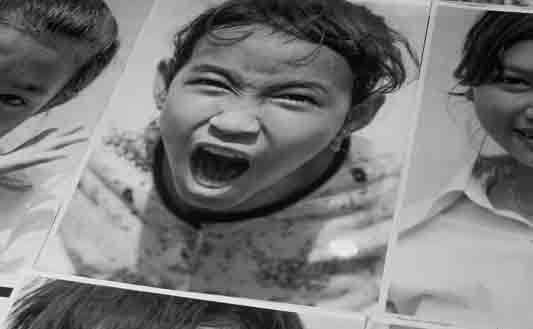The young Vietnamese girl stripped naked and screaming from napalm burns. The crouched, starving Sudanese child stalked by a vulture. As words and numbers morph into real people with lived experiences, a single shot demonstrates its capacity to transcend the statistical anonymity of humanitarian disaster and bring us face to face with actual humanity. But what about hundreds of thousands of shots?
This is the question posed by enigmatic French ‘artivist’ JR on being awarded the $1 million TED prize for the chance to create an international project for meaningful social advance. “Can art change the world?” he asks. Maybe we should change the question: can art change people’s lives?
Borne of this premise is the Inside Out project, a global participatory arts movement aimed at giving everyone – and they mean EVERYONE – the opportunity to unite in sharing their portrait and a statement of what they believe in. The format is simple: stark, black-and-white head-and-shoulder shots printed on 36 x 53-inch posters pasted publicly. Untold stories of personal identity transformed into communal works of expression and art. Metaphorical passports to the world.
Covering such themes as gender equality, climate change, racial tolerance and hope, the project has spawned nearly 200,000 portraits since 2011 in more than 100 countries across every continent. And it’s now set for its Cambodian debut to mark the launch of Kampot’s new collaborative community arts’ space, lightbox.
It may seem ironic that as society reaches its narcissistic nadir in the Age of the Selfie – a world where any random thought can be causally splashed across Twitter – oversized portraits with accompanying personal messages would be the chosen medium for an attempt at uniting. But while the Facebook community can create a contrary sense of alienation, an interpersonal disconnect with heads hidden behind digital devices in distant engagement, the direct rawness of the Inside Out installations have the power to bring our shared humanity to the immediate fore.
Titled Move Kampuchea, the 40 larger-than-life portraits in the lightbox exhibition focus on rural schoolchildren with a message of cultural renewal and the reclamation of personal and social identity. On initial viewing, it’s almost impossible not to draw parallels with the forever haunting black-and-white victim profiles at Tuol Sleng. But the difference here is hope: kids laughing and smiling; kids clowning and frowning. The very faces of Cambodia’s future.
This theme of regeneration reflects the broader aspirations and ethos of the lightbox gallery and its project partner Mayibuye, an enterprise aimed at delivering extracurricular creative-arts education to disadvantaged children. The gallery provides an inclusive space for exhibitions, screenings, live performance and workshops in contemporary and traditional arts, along with offering residencies and support for emerging young talent. The desire is to encourage and facilitate community participation and collaboration, both locally and nationally, with the aim of rebuilding cultural identity as a platform for the future following the terrible ruptures of the past.
For Move Kampuchea, coordinator Katharina Glynne enlisted the help of photographer Ellen Meyer to run workshops and act as mentor in basic photography, but the final direction of the shoot was left to the children themselves. Each took photographs of their peers, and that sense of empowerment and ownership shines through in the collection. It’s the expression of identity as both artist and subject.
So can art change people’s lives? While the lightbox team appreciates that arts education may not be at the forefront of basic needs, they believe the creative thinking engendered by self-expression to be an important element in the progression of society. By giving folk the chance to get involved in the arts, it’s hoped a new generation of creative young thinkers will help move the country toward a more dynamic future.
WHO: Creative thinkers
WHAT: Move Kampuchea photo exhibition
WHERE: lightbox Gallery, Kampot (turn left at the Bobor corner north of Old Bridge Street)
WHEN: June 5 – 8
WHY: They’ve seen the future – and it’s dynamic
